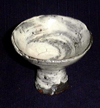Earthenware - Japanese Traditional Culture | Landscape (Keshiki)
TOP -- How to Make -- Landscape
Landscape (Keshiki)
When looking at a pot there are many ways to describe it - by shape, color, function, glaze, or style. The Japanese have taken it one step further and view the landscape (keshiki) on a piece. Keshiki involves how the glaze flows, stops and pools, the color of the clay, the creating process, or how kiln occurrences play out on the surface. Keshiki affects the value of pieces. Certain keshiki are found on certain styles more than others. For example, hi-iro occurs with Shigaraki quite often, but never on Karatsu ware. This page introduces you to some of the more common keshiki.
Name
|
Description |
Picture |
Amamori |
A "leaky roof" grouping of stains or spots - mostly found on kohiki wares. |  |
Bebera |
An accidental break in a piece, usually on the lip where a potters trimming tool has hit or skipped over an impurity. |  |
Bidoro |
"Vitrified glass" taken from the Portuguese word for glass. Found mainly on Iga wares. Also sometimes called a tombo no me (or dragonfly's eye). |  |
Hakeme |
White slip that has been applied with a stiff brush. |  |
Koge |
"Scorch" markings found on Ki-Seto and Iga wares. |  |
Yamamichi |
A "mountain path" lip - sometimes also called Gokaku or Gohou for the lip looks like five mountains from China. |  |
Copyright© Earthenware All Rights Reserved.
